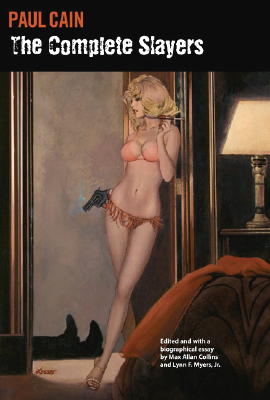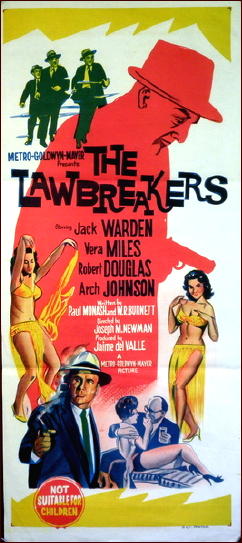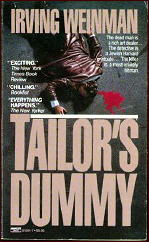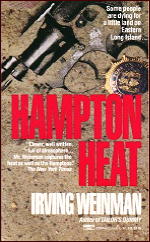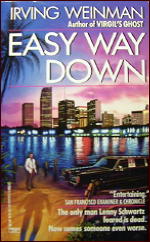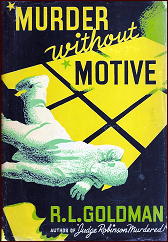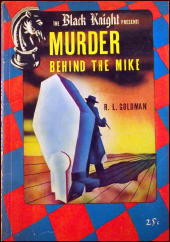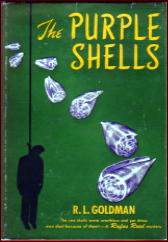April 2012
Monthly Archive
Wed 11 Apr 2012
REVIEWED BY WALKER MARTIN:
PAUL CAIN – The Complete Slayers. Edited and with a biographic essay by Max Allan Collins and Lynn F. Myers, Jr. Centipede Press, hardcover, March 2012.
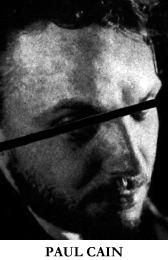
Recently I was very impressed by a collection of hardboiled literature and we discussed it here on Mystery*File. I’m talking about Frederick Nebel’s The Complete Casebook of Cardigan. Around the same time, a second collection was published, this time by Paul Cain (no relation to James Cain). The book is titled The Complete Slayers and has created a buzz on the internet and in some discussion groups.
Paul Cain’s career was far shorter than Frederick Nebel and except for one short story in 1949, all his fiction appeared during the period between 1932 and 1936. At least three major newspapers have reviewed the book, one did not like it and the other two loved it.
In The Wall Street Journal, Lee Sandlin bluntly states, “Cain wasn’t any good.” However in The Washington Post, Michael Dirda, who won a Pulitzer Prize for his reviews, gives the collection a very favorable review and stresses Raymond Chandler’s quote about Paul Cain’s style being “some kind of high point in the ultra hard-boiled manner.”
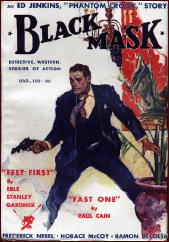
He then finishes his long review by saying, “There’s absolutely nothing to criticize about the knockout stories inside the book…” The Los Angeles Review of Books also gives it a favorable long review and discusses “The grim hardness of a neglected noir master.”
I’ve been a long time admirer of Paul Cain and first read his work in Black Mask back in the 1970’s when I was picking up back issues for only a few dollars each. Of the 20 stories in this collection, 17 of them first appeared in Black Mask. Five were combined and published as Cain’s only novel, Fast One.
I reread the novel a couple times over the years and now with this collection, which reprints the novel in its original magazine form, I feel I can safely say that Fast One definitely deserves to be on any list of the 10 best hardboiled novels.
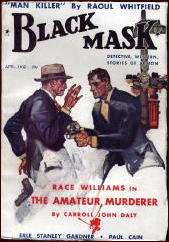
On a recent panel at PulpFest in Columbus Ohio, the topic was Black Mask and the consensus was that Paul Cain was one of the very best writers for the magazine, after of course, Dashiell Hammett and Raymond Chandler. Exactly how editor Joseph Shaw discovered Paul Cain is still a mystery but we can recreate some of the details of what must have happened.
In 1930 Dashiell Hammett stopped writing for Black Mask. He had been writing for the magazine for several years and had just about created the hardboiled detective. I say just about because some scholars also credit Carroll John Daly. He left not because of any disagreement but simply because the movie industry in Hollywood paid far more money.
Shaw even sent Hammett a check for $500 as an advance on another story, but this money was now just pocket change since Hollywood was paying more than this every week.

In an attempt to replace Hammett, Joseph Shaw got Frederick Nebel to start writing a series about another agency detective called Donahue. There were over a dozen of these novelets, which will soon see publication as Tough As Nails (Altus Press). Then in 1932 he discovered Paul Cain, and it’s obvious that Cain was encouraged to write in the Hammett, tough hardboiled style.
The first story by Cain appeared in the March 1932 issue of Black Mask and was called “Fast One” The first novelet of a series that would eventually be published as the novel, Fast One.
It stars Gerry Kells and relates the complicated plot of how Kells gets involved in gambling and corrupt politics. The story is very bleak, very violent, very fast.
Kells gets his face carefully kicked, sapped on the head, shot in the leg, an ice pick in the back, and finally a car crash. If you are looking for a clean cut hero with a happy ending, then this is not the book for you.
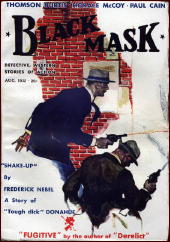
His girlfriend Granquist has no first name and is a drunk. Again, not your typical pretty, young heroine of most novels. In fact I consider her to be one of the most believable gangster girlfriends that I have read about.
Then in 1933, Shaw discovered Raymond Chandler as the hunt to replace Hammett continued. In 1936 Joseph Shaw left Black Mask over a salary dispute and he had such a big influence that several writers also quit the magazine.
When he left, so did Paul Cain, Frederick Nebel, and Raymond Chandler. Lester Dent also stopped writing for the magazine. He only wrote two hardboiled stories but he might have written more with Shaw’s encouragement. The magazine became quite different after Shaw left, certainly less hardboiled.
The Complete Slayers is published by Centipede Press in a special 500 copy edition, signed by the editors and the artist, Ron Lesser. The cover price is $75 but I see that amazon.com still is discounting it at $47.
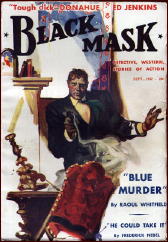
This book is definitely worth the price. There are 622 pages, a biographical essay about Cain’s life, a 13 page color section of book and magazine covers, and each story has an introduction. The dust jacket cover is a knockout showing a scantily dressed blond, casually pointing a gun at some guy lying on the floor.
There is one incorrect statement in the biography that has to be pointed out. The editors state that after Shaw left Black Mask in 1936, Daisy Bacon took over as editor. Daisy worked for Street and Smith and was responsible for the astounding success of Love Story, which was the biggest seller of all the pulp magazines. I’ve heard circulation reports of 600,000 a week.
She eventually became editor of Detective Story in the 1940’s but at no time did she ever edit Black Mask. The lady who took over after Shaw was Fanny Ellsworth(1936-1940). Then Ken White became editor in 1940 when Popular Publications bought the title.
If you like hardboiled fiction or the tough Black Mask style, then this collection is a must buy. It gets my highest recommendation.
Wed 11 Apr 2012
Posted by Steve under
Reviews[5] Comments
IT’S ABOUT CRIME, by Marvin Lachman
JOHN STEPHEN STRANGE – The Strangler Fig. Doubleday Doran/Crime Club, hardcover, 1930. Reprinted in paperback as Murder at World’s End: Mystery Novel Classic #59, no date stated, [1944].
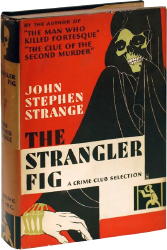
Had I but known what awaited me in John Stephen Strange’s The Strangler Fig, I’d have left this Crime Club mystery for Bill Deeck to review because only he can really do justice to the gems within. How about some of the following H-I-B-K beauties from this book:
“… his eminently reasonable mind entertained no faintest premonition that in a few hours this smoldering fire was destined to burst Into an uncontrollable conflagration.”
Or:
“Perhaps it was just as well that … he could not see with greater clarity what awaited him — what awaited them all — at the turn of the next corner.”
Strange’s amateur sleuth is Baltimore attorney Bolivar Brown, who goes to World’s End Island off the Florida coast where there was a disappearance seven years ago, and now a murder. A hurricane occurs, as obligatory in Florida mysteries of the 1930s as drugs are in the 1980s.
Superstition ascribes the ability to murder to the titular tree, but Bolivar knows better, as he says, “I shall not rest until I am able to call the strangler fig by its human name.”
The book proceeds for too many pages (295) toward a fairly guessable denouement in which Brown gathers all the suspects together. Before he has made any disclosure, Strange (a pseudonym for Mrs. Dorothy Stockbridge Tillet) gives us more wonderful cliches:
“Do you really mean that one of us is a murderer?” and “Do you mean to say that you know who committed these murders?”
This is a quaintly old-fashioned mystery whose plot, characters, and atmosphere are not strong enough to warrant the time spent. However, the unconscious humor made it worthwhile.
— Reprinted from The MYSTERY FANcier,
Vol. 11, No. 1, Winter 1989.
Bibliographic Notes: Mrs. Tillet wrote a total of 22 mystery novels in her career, the first appearing in 1928, the last, The House on 9th Street, in 1976 when she was 80 years old. All of them were published under Doubleday’s Crime Club imprint. While she used other leading characters more than once, this was the only appearance of Bolivar Brown.
Wed 11 Apr 2012
Posted by Steve under
Reviews[7] Comments
THE ARMCHAIR REVIEWER
Allen J. Hubin
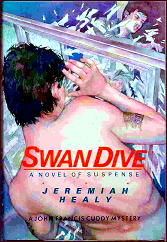
JEREMIAH HEALY – Swan Dive. Harper & Row, hardcover, 1988. Pocket, paperback, 1989.
Your name is John Francis Cuddy, Boston private eye. You’ve lost your beloved wife to cancer, and you go frequently to commune at her gravesite, to leave a flower, to talk with her about what’s happening in your life.
What’s happening Is Nancy Meagher, an assistant D.A., whom you may come to love when your affections recover from wifely loss. What’s also happening is that a friend, a fearfully incompetent lawyer named Chris, with a wife in the latter stages of M.S., asks you to help in a divorce action he’s handling.
Wants you as a bodyguard, actually, since he’s afraid of the husband. With good reason, it develops, for soon you’re fighting for your life in the underbelly of the city, and the cops have your name on a double murder.
This is Swan Dive by Jeremiah Healy, a very satisfying read as Cuddy tries to find the way out of a no-win situation.
— Reprinted from The MYSTERY FANcier,
Vol. 11, No. 1, Winter 1989.
Editorial Comment: Swan Dive was the fourth of 13 novel adventures of PI John Francis Cuddy; there have also been two short story collections. Since the most recent novel was Spiral in 1999, it is safe to assume that after nearly automatic yearly appearances over a period of fifteen years, there will be no more.
Tue 10 Apr 2012
Posted by Steve under
Reviews[5] Comments
CAROLA DUNN – Anthem for Doomed Youth. St. Martin’s/Minotaur Books, hardcover, March 2011; trade paperback, February 2012.
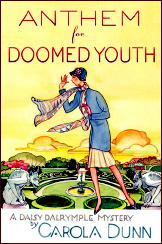
It is hard to believe that this is the 19th in Carola Dunn’s Daisy Dalrymple series. It has to rank high in the list of long-running series still in progress, and it’s all the more remarkable considering that the first one, Death at Wentwater Court, was published in 1994, which (at times) seems like only yesterday.
Of course, unless you hadn’t heard, Daisy is now Daisy Dalrymple Fletcher, happily married to DCI Alex Fletcher of Scotland Yard, and the stepmother of one young lady and the mother of a pair of twins just beyond infancy. The only source of discontent between husband and wife is when Daisy manages to get involved in one of Alex’s cases, which happens, to the avowed disapproval of Alex’s superiors, more often than not.
A long-running series means that readers have gotten fond of a character and keep coming back for more. It has to be challenge to keep the character interesting – which means change – while not annoying readers — who might not like change as much as an author does, not wishing to tell the same story over and over.
From my perspective, the series has changed noticeably since I last read one of them, which was very early on in her list of cases to be solved. Daisy’s adventure then – I misremember which – was light-hearted and cozy all the way through. She was young at the time, while in Anthem she seems a lot more matronly, or well on her way to such status, with equally matronly friends with children the same ages as hers.
The story in Anthem is darker, too, reflecting the time in England a lot more accurately than I recall was the case in her earlier adventures. It is 1926, between the wars, and it is the aftereffects of the first one that are at the root of the three murders Alex is confronted with: three men shot through the heart and buried in an isolated woods at staggered times over the past few months.
This makes Alex’s half of the story the primary one, one he deals with competently but without great challenge, but it is the cause for the darker mood of the overall story. Daisy, on the other hand, finds herself with a separate unexplained death on her hands, that of a headmaster at the boarding school her stepdaughter attends. His body is found in the middle of a maze near the school grounds, an unliked (and unlikeable) man in life, one who would make any number of wishers of his demise without half trying.
Are the two cases connected? You will have to read to find out. While the ending is worth the wait, it does take a while for Daisy to have anything to do – about 130 pages into a 290 page book. Longtime fans of the series won’t mind. Others who are not might get a little impatient.
Tue 10 Apr 2012
THE LAWBREAKERS. MGM, 1961. Jack Warden, Vera Miles, Ken Lynch, Arch Johnson, Robert H. Harris, Robert Douglas, Jay Adler, Robert Bailey. Theme & background music: Duke Ellington. Screenwriters: Paul Monash & W.R. Burnett. Director: Joseph M. Newman.
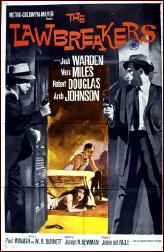
Among several other sources, IMDB says that this film was cobbled together from two episodes of The Asphalt Jungle, a tough, hardboiled crime series shown on ABC in 1961 as a summer fill-in. Combing through the list of episodes and their descriptions, however, the only matchup that fits is that of a single episode, “The Lady and the Lawyer,†the second in the series (9 April 1961).
Some material may have come from the previous episode, to help establish the characters, but there’s only one real story line, that of a big name attorney who works for the local syndicate on the side. He also has money problems. Trying to support a wife and family as well as a mistress (Vera Miles) extends his resources too far – the lady has expensive tastes – and when desperation sets in, well, that’s where the story begins.
Jack Warden plays the guy on the other side, a cop, and an honest one. Promoted to Commissioner when his predecessor can’t stand the heat, he proves to be formidable force against crime. He succeeds easily enough in this film, but I’ll have to come up with the rest of the series on DVD before I can tell you how he fares from here on out.
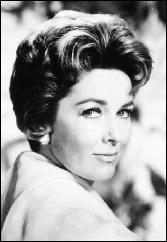
As a femme fatale, Vera Miles is beautiful and alluring enough, but (to my mind) rather too icy cold to compare with the more sultry ladies who often appeared in the noir films of the 50s and 60s – more of a Grace Kelly type than an Audrey Totter or Marie Windsor. Not that she’s a pushover, by any means, not at all. You have to keep a close eye on women like this.
There are several killings in the movie, served well by the black-and-white camera work, with one of the dead men being that of Bob Bailey’s character, the latter being one of the better players of Johnny Dollar on Old-Time Radio – he had one of the toughest voices to ever come from a man so slim. His part in The Lawbreakers may have been his longest roles in the movies, even though (sad to say) his character’s part ends so quickly.
Overall, then, even though concocted somehow from a TV series, the film works well as a film, especially if you like your movies hardboiled and tough, which this movie is, except when Jack Warden breaks down a delivers a sort of sappy soliloquy to the press in a plea for some cooperation. He meant well, but I wish he hadn’t done it.
Note: For more about The Lawbreakers, check out Mike Grost’s website, and the usual detailed analysis he does of all the movies he covers.
Mon 9 Apr 2012
IRVING WEINMAN – Virgil’s Ghost. Fawcett Gold Medal, reprint paperback, January 1991. First published by Columbine, hardcover, 1990.
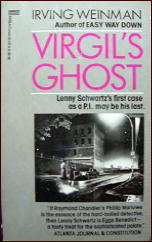
Lenny Schwartz, the hero of Weinman’s two previous mystery novels, turns PI in this one. Years of guilt as a homicide policeman have taken their toll. (I haven’t read the first two, so that is all I know, but as you will see, if you read on, neither am I about to.)
Lenny’s wife is upset by this decision for some reason, but maybe mostly because he didn’t tell her. Not, that is, until the night before he is to move into his new office. She kicks him out, saying that he is welcome home only on weekends, the next few of which they spend making love and feeling guilty afterward.
So Lenny’s first case is important to him, more important than he knows. The parents of a mathematician whose mutilated body was recently found in the East River want him to prove that the coroner’s report was wrong, that their son did not die of AIDS. They feel guilty about this, but they are determined to pursue this course of action.
Mixed in with all this guilt is a load of ethic humor (mostly Jewish), and fifty pages was as far as I went. Lenny’s new assistant is named Abrasha Addison (formerly Yarmolinksy), but at one time his real name was Abraham Resnick, and he can get a deal for you. When Lenny’s office/apartment is trashed by a firebomb, Abrasha is on the spot with a suitcase of clothes for Lenny. “What you think? Just your sizes, Lenny. No? Look, is first drawer quality. Bloomie’s Abe Strauss, good stuff, Huh?”
The murder is serious, however. Pornography is hinted at. Snuff films. According to the back cover, perversion, conspiracy, and cover-ups are involved. Seamy sex clubs and drugs. Government agencies. Russkies. The Nuclear Regulatory Agency. Heaven help us. Can’t anyone write a plain old PI story any more?
Anyway, I didn’t read most of this, but eight different newspapers and review services are liberally quoted on both covers, and they all read it and liked it, and you may, too. One of them even suggests that thus “great new literate sleuth” is “the American version of Adam Dalgleish.” I wouldn’t go that far, based on what I read, but I’d have to admit that I no longer read P. D. James either, and a lot of people do.
— Reprinted from Mystery*File 28,
February 1991 (slightly revised).
The Lenny Schwartz series —
Tailor’s Dummy. Atheneum, 1986.
Hampton Heat. Atheneum, 1988.
Virgil’s Ghost. Columbine, 1990.
Easy Way Down. Columbine, 1991.
[UPDATE] 04-09-12. One never knows for sure, but there’s a good possibility I would find something to reverse my opinion of this book, were I to read it now. Something as simple as my mood at the time may be different, or some eleven years later, certain overall ways I view things may have changed. On the other hand, I have not read P. D. James since I wrote this review, so perhaps not.
Mon 9 Apr 2012
REVIEWED BY DAN STUMPF:
WHISTLING IN THE DARK. MGM, 1933. Ernest Truex, Una Merkel, Edward Arnold, John Miljan, C. Henry Gordon, Johnny Hines, Joseph Cawthorn, Nat Pendleton. Screenwriter/director: Elliott Nugent.
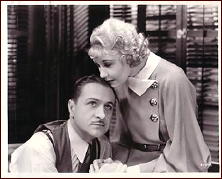
If you have seen His Girl Friday with Rosalind Russell, you might remember the pretentious little pipsqueak poet whose desk Cary Grant tries to steal. That part was played by Ernest Truex, a busy character actor specializing in milquetoast roles, who once actually starred in a film, Whistling in the Dark, a second feature served up in lavish MGM style, with Edward Arnold (who starred with Truex on Broadway in this), Una Merkel and a host of gangster-types.
The plot has Truex as a mystery writer eloping with heiress Merkel when they blunder into a house full of crooks — who are plotting to murder somebody. Truex is quickly drafted into service as plotter-in–chief, and his efforts to devise a scheme, foil the scheme, and escape with Merkel form the basis of a mostly fast-moving hour or so.
Truex plays off his typecast meekness to good effect against menacing actors like Nat Pendleton and C. Henry Gordon, Una Merkel is charmingly simple and sexy in her underclothes, and Edward Arnold radiates ruthless geniality with his usual aplomb.
I just wish they hadn’t tried to open this out by tacking on fifteen minutes of rather lackluster gangster-movie stuff at the start. It slows things down considerably.
Sun 8 Apr 2012
THE BACKWARD REVIEWER
William F. Deeck
R. L. GOLDMAN – Death Plays Solitaire. Coward-McCann, hardcover, 1939. Green Dragon #10, digest-sized paperback, no date stated [1944], condensed.
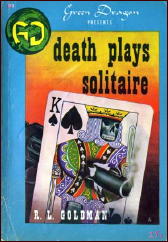
While it will not endear me to the doubtless many fans of Asaph Clume and Rufus Reed, “impulsive redheaded reporter,” I must confess I am glad I read the “condensed” version of this novel since its tediousness is staggering even in the abbreviated version.
For example: “I’m supposed to be a political commentator, and I do a daily column, ‘Round-Up,’ which I sign ‘Rufus Reed’ because that’s my name.”
A former police reporter, Reed has been assigned by Clume, his boss, to cover the execution of Dan Hillyard for murder during a bank robbery from which the money has never been recovered. On his last night Hillyard gives the deck of cards with which he has been playing solitaire to his wife.
In turn, she gives the cards to Hillyard’s lawyer, who is murdered shortly afterwards. He, too, had been playing solitaire, something he had never done before, and the deck of cards has been taken by the murderer. Other deaths follow, and Reed himself faces torture and death. As Reed does the leg work, Clume does the thinking, such as it is.
Not well written even for the times, a very thin plot, an evident but clueless murderer. Still, one waits, not breathlessly, to read The Snatch, in which, according to Green Dragon, “A slipping male movie idol is the victim-and there are more than enough suspects with motives. Irrepressible Rufus Reed, red-haired reporter figures out whodunit just in time for a smashing, surprise ending that’ll leave you worrying about ethics for quite a while.”
— From The MYSTERY FANcier, Vol. 11, No. 1, Winter 1989.
The Asaph Clume & Rufus Reed series —
The Murder of Harvey Blake. Skeffington, 1931.
Murder Without Motive. Coward, 1938.
Death Plays Solitaire. Coward, 1939.
The Snatch. Coward, 1940.
Murder Behind the Mike. Coward, 1942.
The Purple Shells. Ziff-Davis, 1947.
Editorial Comment: R. L. Goldman also wrote three non-series mysteries not included in the list above. Some biographical information about him can be found in the Ziff-Davis “Fingerprint Mystery” checklist compiled by Victor Berch, Bill Pronzini and myself.
Sat 7 Apr 2012
Reviewed by Michael Shonk
I DEAL IN DANGER. 20th Century Fox, 1966. Compiled from the first four episodes of the TV series Blue Light. Robert Goulet, Christine Carère, Horst Frank, Donald Harron, Werner Peters, Eva Pflug, John van Dreelan. Written by Larry Cohen. Produced by Buck Houghton. Directed and Executive Produced by Walter Grauman.
For those who visit here just to read the articles and reviews, but don’t read the comments, you are missing out on half the fun. Why it is like buying Playboy just to read the articles and ignore the pictures!
During the comments for my original look at the TV series Blue Light, David Bushman of the Paley Center mentioned a detailed look at the series in Television Chronicles, featuring interviews with Larry Cohen and Walter Grauman.
Randy Cox was kind enough to send me a copy. I had originally updated the comments for the original Blue Light review, but thought an update and review of the movie made from the first four TV series episodes might be of some interest.
It began with Walter Grauman:
“I was a World War II veteran, a pilot in World War II in Europe, and flew B-25 bombers, and I was always fascinated with the war. I don’t know what gave me the idea, I don’t remember at this point, and I don’t know why I liked the title Blue Light. I just did.â€
Cohen wrote a screenplay for the Mirisch company (Return of the Seven) and was at the Walter Mirisch’s office when he met Grauman, who was close friends with Mirisch. They started to discuss ideas for a TV series. Grauman mentioned his idea for WWII spies and the title Blue Light. It was Cohen who then came up with the format of an American turncoat who goes to Germany, poses as a Nazi sympathizer who broadcasts against the Allies, but was really a double agent.
There were discussions about the title. Cohen at one time suggested the title 13 Rue Madeleine after the Fox movie with James Cagney. But in the end it was decided to keep the title Blue Light.
Walter Grauman and Robert Goulet were represented by the same agency, CMA. As Grauman explained, “When Bill Self, then the head of Fox was interested in the show, CMA said, ‘Look, we can package it with a name’…â€
William Self liked the idea and the star, and he sold it to ABC.
Cohen added that Goulet had a development fund to have scripts written for him to star. It was Goulet’s company that paid Cohen to write the pilot script. Everyone, including ABC, liked the script. ABC was so pleased with the script they bought the series, a seventeen episode commitment, before the pilot was even filmed.
The first episode, despite a trade paper critic’s raves about the on location shooting, was shot in Los Angeles. The filming in Germany began with the next episode.
Larry Cohen remained in Los Angeles and at the Fox studio lot, while Walter Grauman headed up the film company to film in Germany. Cohen explained why he did not go to Germany. It was Christmas time and Cohen did not want to leave his family.
[As a brief aside, notice the speed this was made. Shooting began in December and first episode aired January 12th.]
Cohen described the writing process for the series, “So, I started the show, and I wrote most of the stories. I wrote outlines for all the stories in the show and gave them out to writers for the writers to write the scripts, but it turned out that most of the scripts weren’t very good, and I ended up having to rewrite them anyway. So it got down to finally just writing all of the scripts myself. Some of them I credited to friends of mine, people I wanted to give a job to.â€
Cohen was having fun wandering the Fox lot and more important to him, “because everything I wrote they shot.†There was no time to change the scripts.
Walter Grauman also fondly remembers the series, but he was having much less fun. Shooting in Germany gave the series a realistic and unique look compared to the other series on the air. But there were production problems. While the Germany crew was good, art director Rolf Zehetbauer would later win an Oscar for Cabaret, they were slower than Hollywood crews.
Grauman explained his problem, “There were two executives at Fox, and one on the show. … They had a ball in Germany. I was shooting 17, 18, hours a day, and Larry was writing the scripts here and sending them (to us). There was no fax in that day, so we just got them by air (mail).
“We started in midseason, and I was falling behind. With each show I’d fall maybe two days, a day behind, and I could see that what was going to happen was that we were going to get to a point where we wouldn’t make our air date.
“I wanted to bring the company back, that was the primary reason, plus the fact that I was exhausted and couldn’t keep doing one show after another. But the guys that were there, the Fox representatives, they loved having the production over there because it was a playground for them.â€
Finally Grauman sent a cable to William Self of Fox saying that he would bring the company home or come home without them. The next day the Blue Light company was headed back to Los Angeles.
The article praised the acting ability of Robert Goulet. Cohen, whom more than once called Goulet a very nice guy, said, “…I guess he was just too good looking for the audience to get past the good looks to the person behind it and all…But he was a good actor. I thought he acted the part well.â€
The character of Suzanne Duchard was mentioned in passing and nothing was said about the actress Christine Carère.
There was an unexpected problem caused by one of the guest cast when everyone involved with the series received a health warning from the Health Department. Werner Peters (Heinrich Elm (“The Last Man†and “Return of Elmâ€) had tuberculosis and would die from the disease.
The ratings were never good. ABC tried the series in other time slots and changed the opening at least three times, but nothing worked and the show was cancelled after its order of 17 episodes.
The article also discusses I Deal in Danger.
Bill Groves wrote, “In the 50s and 60s, it was not uncommon for half-hour TV episodes to be thus edited together as features and make the rounds of the drive-in circuit, and the practice is still utilized today (1996) to some extent for foreign release.
Larry Cohen explained, “It was my idea when I wrote them to be able to put four shows together and make a feature. I told them, ‘Let me write four shows continuous, and that way you can make a feature picture out of them for syndication or for Europe or something.’ I didn’t realize they were going to release the picture theatrically in America, which they did. It actually played on a double-feature with a James Garner movie in New York called Mister Buddwing, and we were the second feature. It played all over New York. I was surprised. And the audience was a little pissed off, too, because some people came out of the theaters saying, ‘Hey, we saw this on television.’…â€
So how was I Deal in Danger? It has the look and budget of the The Man from U.N.C.L.E. theatrical films also put together from TV episodes. I Deal with Danger was more seamless than the usual such attempt and is worth watching on DVD.
Cohen’s attempt to write four half hour episodes and turn it into an hour and thirty-three minute movie was more noticeable when it aired as half hour episodes than as a movie. When I watched the series I wondered if this was an early arc series where each story lead into the next. I also wonder if Blue Light lost viewers who agree with those today who prefer their stand-alone episodic series versus the time investment that is required for a multi-part series.
The movie version is edited from the first four episodes (“The Last Man,†“Target David March,†“The Fortress Below,†and “The Weapon Withinâ€). Most notably missing was the main plot of “Target David March†where a British officer decides on his own to send in three Commandos to assassinate March. It was not missed.
Until the series is available, I Deal with Danger is a worthy substitute.
Source:
Television Chronicles: Issue 5 (April 1996). Rubber Chicken Publication. Managing Editor/Writer: Bill Groves. Publisher: Donovan Brandt.
Sat 7 Apr 2012
Maybe you can help.
I am going nuts trying to find the title for a crime movie I saw on TV in the mid-70’s. Only caught the last half and I don’t recall any major stars.
The plot: a group of detectives are in a police office after hours waiting for one of the number to come in. In strolls a woman with a gun and a bottle of nitroglycerin. She claims the detective killed her husband and she’s going to kill him when he arrives. If any of the other detectives interfere, she’ll shoot the bottle of nitro and blow the whole office sky-high. Much tension ensues.
Does this movie sound familiar?
— Tim Mayer
« Previous Page — Next Page »






